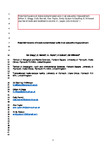Potential hazards of metal-contaminated soils in an estuarine impoundment
| dc.contributor.author | Glegg, Gillian | |
| dc.contributor.author | Barratt, C | |
| dc.contributor.author | Taylor, A | |
| dc.contributor.author | Gulson, E | |
| dc.contributor.author | Millward, GE | |
| dc.date.accessioned | 2021-04-20T08:58:16Z | |
| dc.date.available | 2021-04-20T08:58:16Z | |
| dc.date.issued | 2021-01-01 | |
| dc.identifier.issn | 1439-0108 | |
| dc.identifier.issn | 1614-7480 | |
| dc.identifier.uri | http://hdl.handle.net/10026.1/17054 | |
| dc.description.abstract |
Purpose: A recreational impoundment was constructed in the mid-nineteenth century on the mudflats reclaimed from the Plym Estuary (SW England) following salt marsh removal and infilling with waste soils from local catchments. Restoration of the salt marsh was attempted about 25 years ago when a regulated tidal exchange system was installed in the embankment separating the impoundment from the estuary. Currently, the embankment is disintegrating with the potential loss of the impounded soils, of unknown composition, to the estuary. Methods: Cores were obtained from the impoundment and the adjoining estuary, sectioned, dried and analysed. The geochronology of the soils, and estuarine sediments, was established using gamma-ray spectroscopy to determine the activities of fallout radionuclides, 137Cs and 210Pb. The concentrations of As, Co, Cr Cu, Fe, Mn, Ni, Pb, Rb, Sn, W and Zn in the core sections were determined by quantitative X-ray fluorescence spectrometry. Results: Below a shallow surface layer (> 5 cm and post-1963), metal concentrations were high with several exceeding soil quality indices, and enrichment factors (EFs) were elevated, in the sequence Sn > W≈As > Cu > Pb. Estimates of the total masses of particulate Sn, Pb, As and Cu available for down-estuary migration were significant. Conclusions: Given the ecotoxicological implications resulting from a loss of metal-contaminated soils into the estuary, a strategy for the future management of the impoundment is required. The conditions at this site are compared with ageing estuarine impoundments at other locations, where polluted sediments, or soils, could be vulnerable to release. | |
| dc.format.extent | 530-544 | |
| dc.language | en | |
| dc.language.iso | en | |
| dc.publisher | Springer Verlag | |
| dc.subject | Estuary | |
| dc.subject | Impoundment | |
| dc.subject | Managed realignment | |
| dc.subject | Contaminated soils | |
| dc.subject | Release | |
| dc.title | Potential hazards of metal-contaminated soils in an estuarine impoundment | |
| dc.type | journal-article | |
| dc.type | Journal Article | |
| plymouth.author-url | https://www.webofscience.com/api/gateway?GWVersion=2&SrcApp=PARTNER_APP&SrcAuth=LinksAMR&KeyUT=WOS:000584956700002&DestLinkType=FullRecord&DestApp=ALL_WOS&UsrCustomerID=11bb513d99f797142bcfeffcc58ea008 | |
| plymouth.issue | 1 | |
| plymouth.volume | 21 | |
| plymouth.publication-status | Published | |
| plymouth.journal | Journal of Soils and Sediments: protection, risk assessment and remediation | |
| dc.identifier.doi | 10.1007/s11368-020-02821-x | |
| plymouth.organisational-group | /Plymouth | |
| plymouth.organisational-group | /Plymouth/Faculty of Science and Engineering | |
| plymouth.organisational-group | /Plymouth/Faculty of Science and Engineering/School of Biological and Marine Sciences | |
| plymouth.organisational-group | /Plymouth/REF 2021 Researchers by UoA | |
| plymouth.organisational-group | /Plymouth/REF 2021 Researchers by UoA/UoA14 Geography and Environmental Studies | |
| plymouth.organisational-group | /Plymouth/Research Groups | |
| plymouth.organisational-group | /Plymouth/Research Groups/Marine Institute | |
| plymouth.organisational-group | /Plymouth/Users by role | |
| plymouth.organisational-group | /Plymouth/Users by role/Academics | |
| dcterms.dateAccepted | 2020-10-25 | |
| dc.rights.embargodate | 2021-10-29 | |
| dc.identifier.eissn | 1614-7480 | |
| dc.rights.embargoperiod | Not known | |
| rioxxterms.versionofrecord | 10.1007/s11368-020-02821-x | |
| rioxxterms.licenseref.uri | http://www.rioxx.net/licenses/all-rights-reserved | |
| rioxxterms.licenseref.startdate | 2021-01-01 | |
| rioxxterms.type | Journal Article/Review |


